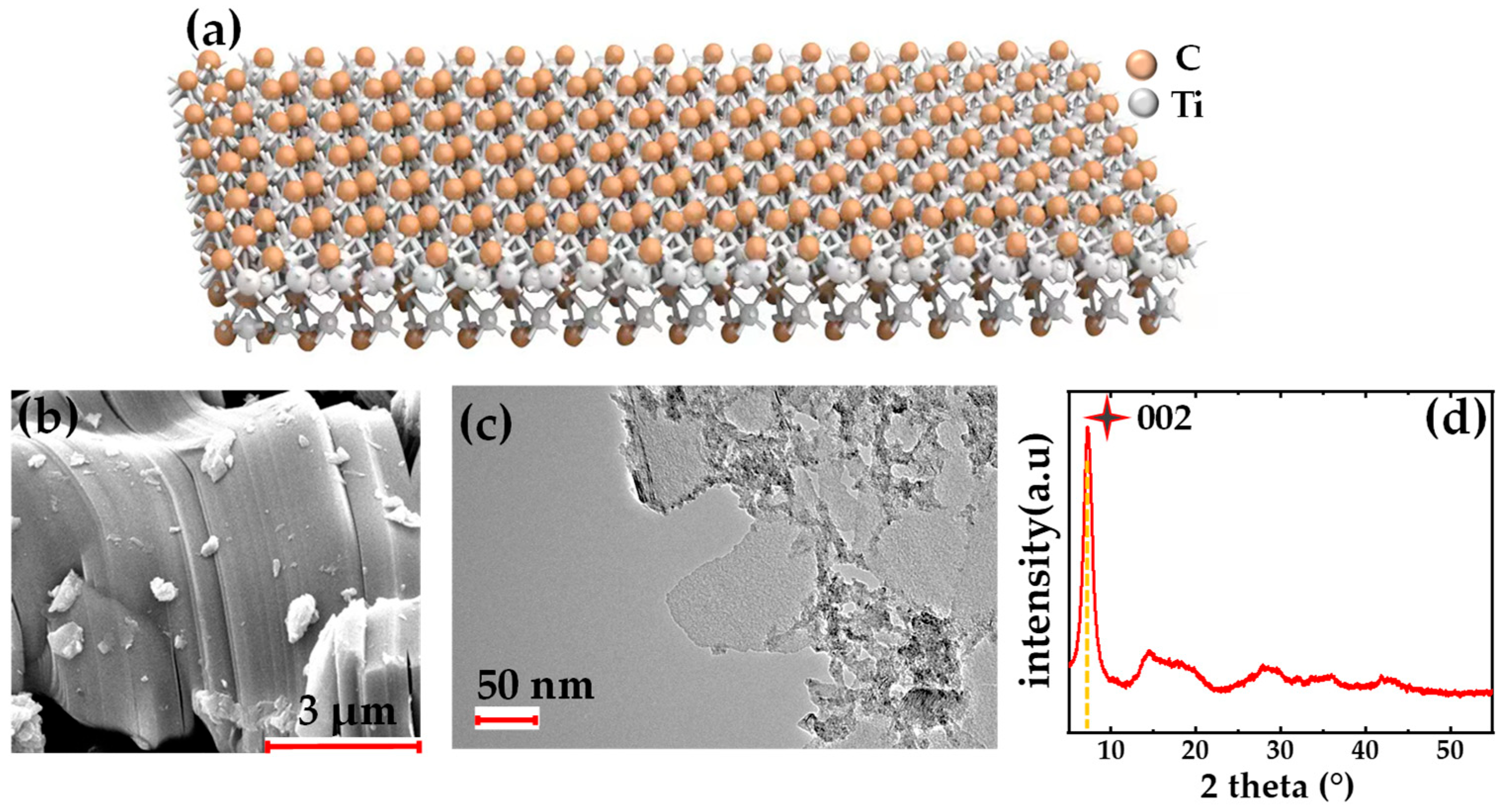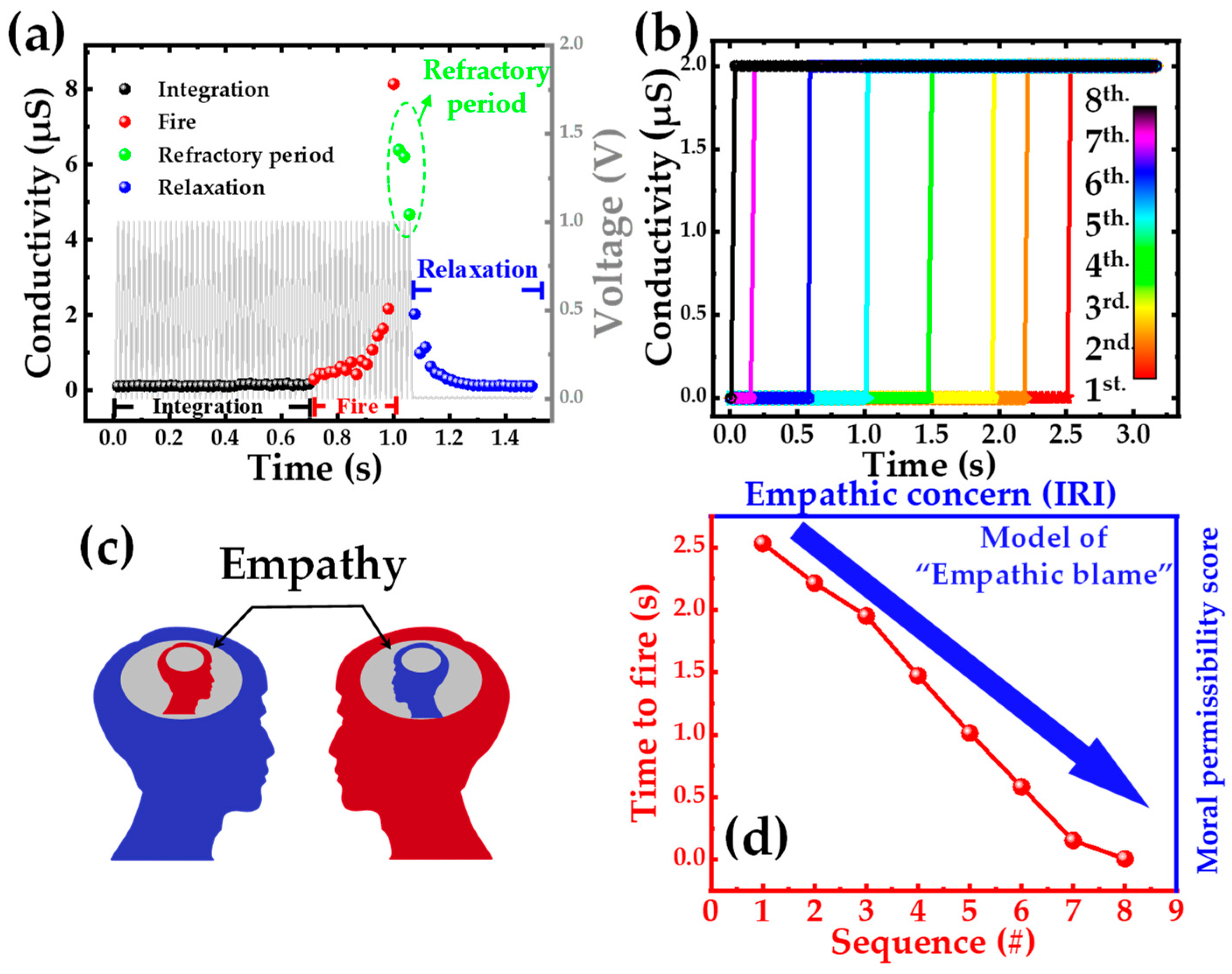Realization of Empathy Capability for the Evolution of Artificial Intelligence Using an MXene(Ti3C2)-Based Memristor
Abstract
:1. Introduction
2. Materials and Methods
3. Results and Discussion
4. Conclusions
Author Contributions
Funding
Data Availability Statement
Acknowledgments
Conflicts of Interest
References
- Cuff, B.M.; Brown, S.J.; Taylor, L.; Howat, D.J. Empathy: A review of the concept. Emot. Rev. 2016, 8, 144–153. [Google Scholar] [CrossRef]
- Patil, I.; Calò, M.; Fornasier, F.; Cushman, F.; Silani, G. The behavioral and neural basis of empathic blame. Sci. Rep. 2017, 7, 5200. [Google Scholar] [CrossRef]
- Decety, J.; Echols, S.; Correll, J. The blame game: The effect of responsibility and social stigma on empathy for pain. J. Cognit. Neurosci. 2010, 22, 985–997. [Google Scholar] [CrossRef] [PubMed]
- Crisan, S.; Canache, M.; Buksa, D.; Nechita, D. A comparison between self-compassion and unconditional self-acceptance: Interventions on self-blame, empathy, shame-, guilt-proneness, and performance. J. Ration.-Emotive Cogn.-Behav. Ther. 2023, 41, 64–80. [Google Scholar] [CrossRef]
- Maharani, F.; Adiningrum, R.; Mohammad, W. Character AI Personas’ Views on User’s Psychological Sin Statements and Self-Blame. Arika J. Digit. Mark. Consum. Behav. 2023, 1, 1–8. [Google Scholar]
- Walkington, Z.; Wigman, S.A.; Bowles, D. The impact of narratives and transportation on empathic responding. Poetics 2020, 80, 101425. [Google Scholar] [CrossRef]
- Ji, X.; Dong, Z.; Han, Y.; Lai, C.S.; Qi, D. A brain-inspired hierarchical interactive in-memory computing system and its application in video sentiment analysis. IEEE Trans. Circuits Syst. Video Technol. 2023, 33, 7928–7942. [Google Scholar] [CrossRef]
- Ji, X.; Dong, Z.; Lai, C.S.; Qi, D. A brain-inspired in-memory computing system for neuronal communication via memristive circuits. IEEE Commun. Mag. 2022, 60, 100–106. [Google Scholar] [CrossRef]
- Dong, Z.; Ji, X.; Wang, J.; Gu, Y.; Wang, J.; Qi, D. ICNCS: Internal cascaded neuromorphic computing system for fast electric vehicle state of charge estimation. IEEE Trans. Consum. Electron. 2023. [Google Scholar] [CrossRef]
- Dong, Z.; Ji, X.; Lai, C.S.; Qi, D. Design and implementation of a flexible neuromorphic computing system for affective communication via memristive circuits. IEEE Commun. Mag. 2022, 61, 74–80. [Google Scholar] [CrossRef]
- Ji, X.; Dong, Z.; Han, Y.; Lai, C.S.; Zhou, G.; Qi, D. EMSN: An energy-efficient memristive sequencer network for human emotion classification in mental health monitoring. IEEE Trans. Consum. Electron. 2023, 69, 1005–1016. [Google Scholar] [CrossRef]
- Ji, X.; Lai, C.S.; Zhou, G.; Dong, Z.; Qi, D.; Lai, L.L. A flexible memristor model with electronic resistive switching memory behavior and its application in spiking neural network. IEEE Trans. Nanobiosci. 2022, 22, 52–62. [Google Scholar] [CrossRef]
- Dong, Z.; Ji, X.; Lai, C.S.; Qi, D.; Zhou, G.; Lai, L.L. Memristor-based hierarchical attention network for multimodal affective computing in mental health monitoring. IEEE Consum. Electron. Mag. 2022, 12, 94–106. [Google Scholar] [CrossRef]
- Ji, X.; Dong, Z.; Lai, C.; Zhou, G.; Qi, D. A physics-oriented memristor model with the coexistence of NDR effect and RS memory behavior for bio-inspired computing. Mater. Today Adv. 2022, 16, 100293. [Google Scholar] [CrossRef]
- Keysers, C. Mirror neurons. Curr. Biol. 2009, 19, R971–R973. [Google Scholar] [CrossRef] [PubMed]
- Iacoboni, M. Imitation, empathy, and mirror neurons. Annu. Rev. Psychol. 2009, 60, 653–670. [Google Scholar] [CrossRef]
- Plata-Bello, J.; Privato, N.; Modroño, C.; Pérez-Martín, Y.; Borges, Á.; González-Mora, J.L. Empathy Modulates the Activity of the Sensorimotor Mirror Neuron System during Pain Observation. Behav. Sci. 2023, 13, 947. [Google Scholar] [CrossRef] [PubMed]
- Kilner, J.M.; Lemon, R.N. What we know currently about mirror neurons. Curr. Biol. 2013, 23, R1057–R1062. [Google Scholar] [CrossRef] [PubMed]
- Heyes, C.; Catmur, C. What happened to mirror neurons? Perspect. Psychol. Sci. 2022, 17, 153–168. [Google Scholar] [CrossRef]
- Oztop, E.; Kawato, M.; Arbib, M.A. Mirror neurons: Functions, mechanisms and models. Neurosci. Lett. 2013, 540, 43–55. [Google Scholar] [CrossRef]
- Miall, R.C. Connecting mirror neurons and forward models. Neuroreport 2003, 14, 2135–2137. [Google Scholar] [CrossRef] [PubMed]
- Strukov, D.B.; Snider, G.S.; Stewart, D.R.; Williams, R.S. The missing memristor found. Nature 2008, 453, 80–83. [Google Scholar] [CrossRef]
- Wang, Z.; Joshi, S.; Savel’ev, S.E.; Jiang, H.; Midya, R.; Lin, P.; Hu, M.; Ge, N.; Strachan, J.P.; Li, Z. Memristors with diffusive dynamics as synaptic emulators for neuromorphic computing. Nat. Mater. 2017, 16, 101–108. [Google Scholar] [CrossRef] [PubMed]
- Yoon, J.H.; Wang, Z.; Kim, K.M.; Wu, H.; Ravichandran, V.; Xia, Q.; Hwang, C.S.; Yang, J.J. An artificial nociceptor based on a diffusive memristor. Nat. Commun. 2018, 9, 417. [Google Scholar] [CrossRef]
- Yao, P.; Wu, H.; Gao, B.; Tang, J.; Zhang, Q.; Zhang, W.; Yang, J.J.; Qian, H. Fully hardware-implemented memristor convolutional neural network. Nature 2020, 577, 641–646. [Google Scholar] [CrossRef] [PubMed]
- Jo, S.H.; Chang, T.; Ebong, I.; Bhadviya, B.B.; Mazumder, P.; Lu, W. Nanoscale memristor device as synapse in neuromorphic systems. Nano Lett. 2010, 10, 1297–1301. [Google Scholar] [CrossRef]
- Xu, Z.; Li, Y.; Xia, Y.; Shi, C.; Chen, S.; Ma, C.; Zhang, C.; Li, Y. Organic Frameworks Memristor: An Emerging Candidate for Data Storage, Artificial Synapse, and Neuromorphic Device. Adv. Funct. Mater. 2024, 34, 2312658. [Google Scholar] [CrossRef]
- Huh, W.; Lee, D.; Lee, C.H. Memristors based on 2D materials as an artificial synapse for neuromorphic electronics. Adv. Mater. 2020, 32, 2002092. [Google Scholar] [CrossRef] [PubMed]
- Wang, M.; Cai, S.; Pan, C.; Wang, C.; Lian, X.; Zhuo, Y.; Xu, K.; Cao, T.; Pan, X.; Wang, B. Robust memristors based on layered two-dimensional materials. Nat. Electron. 2018, 1, 130–136. [Google Scholar] [CrossRef]
- Teja Nibhanupudi, S.; Roy, A.; Veksler, D.; Coupin, M.; Matthews, K.C.; Disiena, M.; Ansh; Singh, J.V.; Gearba-Dolocan, I.R.; Warner, J. Ultra-fast switching memristors based on two-dimensional materials. Nat. Commun. 2024, 15, 2334. [Google Scholar] [CrossRef]
- Zhu, K.; Pazos, S.; Aguirre, F.; Shen, Y.; Yuan, Y.; Zheng, W.; Alharbi, O.; Villena, M.A.; Fang, B.; Li, X. Hybrid 2D–CMOS microchips for memristive applications. Nature 2023, 618, 57–62. [Google Scholar] [CrossRef] [PubMed]
- Li, M.; Liu, H.; Zhao, R.; Yang, F.-S.; Chen, M.; Zhuo, Y.; Zhou, C.; Wang, H.; Lin, Y.-F.; Yang, J.J. Imperfection-enabled memristive switching in van der Waals materials. Nat. Electron. 2023, 6, 491–505. [Google Scholar] [CrossRef]
- Xie, M.; Jia, Y.; Nie, C.; Liu, Z.; Tang, A.; Fan, S.; Liang, X.; Jiang, L.; He, Z.; Yang, R. Monolithic 3D integration of 2D transistors and vertical RRAMs in 1T–4R structure for high-density memory. Nat. Commun. 2023, 14, 5952. [Google Scholar] [CrossRef] [PubMed]
- VahidMohammadi, A.; Rosen, J.; Gogotsi, Y. The world of two-dimensional carbides and nitrides (MXenes). Science 2021, 372, eabf1581. [Google Scholar] [CrossRef] [PubMed]
- Gogotsi, Y.; Anasori, B. The rise of MXenes. ACS Nano 2019, 13, 8491–8494. [Google Scholar] [CrossRef] [PubMed]
- Gogotsi, Y.; Huang, Q. MXenes: Two-dimensional building blocks for future materials and devices. ACS Nano 2021, 15, 5775–5780. [Google Scholar] [CrossRef]
- Naguib, M.; Kurtoglu, M.; Presser, V.; Lu, J.; Niu, J.; Heon, M.; Hultman, L.; Gogotsi, Y.; Barsoum, M.W. Two-dimensional nanocrystals: Two-dimensional nanocrystals produced by exfoliation of Ti3AlC2 (Adv. Mater. 37/2011). Adv. Mater. 2011, 23, 4207. [Google Scholar] [CrossRef]
- Naguib, M.; Mashtalir, O.; Carle, J.; Presser, V.; Lu, J.; Hultman, L.; Gogotsi, Y.; Barsoum, M.W. Two-dimensional transition metal carbides. ACS Nano 2012, 6, 1322–1331. [Google Scholar] [CrossRef] [PubMed]
- Kumar, J.A.; Prakash, P.; Krithiga, T.; Amarnath, D.J.; Premkumar, J.; Rajamohan, N.; Vasseghian, Y.; Saravanan, P.; Rajasimman, M. Methods of synthesis, characteristics, and environmental applications of MXene: A comprehensive review. Chemosphere 2022, 286, 131607. [Google Scholar] [CrossRef]
- Zhan, X.; Si, C.; Zhou, J.; Sun, Z. MXene and MXene-based composites: Synthesis, properties and environment-related applications. Nanoscale Horiz. 2020, 5, 235–258. [Google Scholar] [CrossRef]
- Nan, J.; Guo, X.; Xiao, J.; Li, X.; Chen, W.; Wu, W.; Liu, H.; Wang, Y.; Wu, M.; Wang, G. Nanoengineering of 2D MXene-based materials for energy storage applications. Small 2021, 17, 1902085. [Google Scholar] [CrossRef] [PubMed]
- Pei, Y.; Zhang, X.; Hui, Z.; Zhou, J.; Huang, X.; Sun, G.; Huang, W. Ti3C2TX MXene for sensing applications: Recent progress, design principles, and future perspectives. ACS Nano 2021, 15, 3996–4017. [Google Scholar] [CrossRef]
- Yan, X.; Wang, K.; Zhao, J.; Zhou, Z.; Wang, H.; Wang, J.; Zhang, L.; Li, X.; Xiao, Z.; Zhao, Q. A new memristor with 2D Ti3C2Tx MXene flakes as an artificial bio-synapse. Small 2019, 15, 1900107. [Google Scholar] [CrossRef]
- Mullani, N.B.; Kumbhar, D.D.; Lee, D.H.; Kwon, M.J.; Cho, S.y.; Oh, N.; Kim, E.T.; Dongale, T.D.; Nam, S.Y.; Park, J.H. Surface Modification of a Titanium Carbide MXene Memristor to Enhance Memory Window and Low-Power Operation. Adv. Funct. Mater. 2023, 33, 2300343. [Google Scholar] [CrossRef]
- Long, Y.; Tao, Y.; Shang, T.; Yang, H.; Sun, Z.; Chen, W.; Yang, Q.H. Roles of metal ions in MXene synthesis, processing and applications: A perspective. Adv. Sci. 2022, 9, 2200296. [Google Scholar] [CrossRef]
- Li, Q.; Li, Y.; Zeng, W. Preparation and application of 2D MXene-based gas sensors: A review. Chemosensors 2021, 9, 225. [Google Scholar] [CrossRef]
- Ebisch, S.J.; Scalabrini, A.; Northoff, G.; Mucci, C.; Sergi, M.R.; Saggino, A.; Aquino, A.; Alparone, F.R.; Perrucci, M.G.; Gallese, V. Intrinsic shapes of empathy: Functional brain network topology encodes intersubjective experience and awareness traits. Brain Sci. 2022, 12, 477. [Google Scholar] [CrossRef]
- Seminowicz, D.A.; Moayedi, M. The dorsolateral prefrontal cortex in acute and chronic pain. J. Pain 2017, 18, 1027–1035. [Google Scholar] [CrossRef]
- Guo, X.; Merrikh-Bayat, F.; Gao, L.; Hoskins, B.D.; Alibart, F.; Linares-Barranco, B.; Theogarajan, L.; Teuscher, C.; Strukov, D.B. Modeling and experimental demonstration of a Hopfield network analog-to-digital converter with hybrid CMOS/memristor circuits. Front. Neurosci. 2015, 9, 488. [Google Scholar] [CrossRef]
- Danial, L.; Wainstein, N.; Kraus, S.; Kvatinsky, S. Breaking through the speed-power-accuracy tradeoff in ADCs using a memristive neuromorphic architecture. IEEE Trans. Emerg. Top. Comput. Intell. 2018, 2, 396–409. [Google Scholar] [CrossRef]
- Wang, W.; Li, Z.; Fu, X.; Wang, Y.; Li, Q. Pipelined Memristive Analog-to-Digital Converter With Self-Adaptive Weight Tuning. IEEE J. Emerg. Sel. Top. Circuits Syst. 2022, 12, 913–921. [Google Scholar] [CrossRef]




Disclaimer/Publisher’s Note: The statements, opinions and data contained in all publications are solely those of the individual author(s) and contributor(s) and not of MDPI and/or the editor(s). MDPI and/or the editor(s) disclaim responsibility for any injury to people or property resulting from any ideas, methods, instructions or products referred to in the content. |
© 2024 by the authors. Licensee MDPI, Basel, Switzerland. This article is an open access article distributed under the terms and conditions of the Creative Commons Attribution (CC BY) license (https://creativecommons.org/licenses/by/4.0/).
Share and Cite
Wang, Y.; Zhang, Y.; Wang, Y.; Zhang, H.; Wang, X.; Xu, R.; Tong, Y. Realization of Empathy Capability for the Evolution of Artificial Intelligence Using an MXene(Ti3C2)-Based Memristor. Electronics 2024, 13, 1632. https://doi.org/10.3390/electronics13091632
Wang Y, Zhang Y, Wang Y, Zhang H, Wang X, Xu R, Tong Y. Realization of Empathy Capability for the Evolution of Artificial Intelligence Using an MXene(Ti3C2)-Based Memristor. Electronics. 2024; 13(9):1632. https://doi.org/10.3390/electronics13091632
Chicago/Turabian StyleWang, Yu, Yanzhong Zhang, Yanji Wang, Hao Zhang, Xinpeng Wang, Rongqing Xu, and Yi Tong. 2024. "Realization of Empathy Capability for the Evolution of Artificial Intelligence Using an MXene(Ti3C2)-Based Memristor" Electronics 13, no. 9: 1632. https://doi.org/10.3390/electronics13091632





